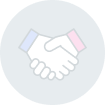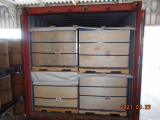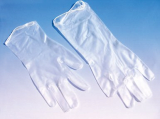Rubber Conductive
Negotiable Min Order Quantity Unit
- Required Quantity
-
- Place of Origin
- Payment Terms
- Negotiable
- Production method
- Negotiable
- Shipping / Lead Time
- Negotiable / Negotiable
- Keyword
- Category
- Other Rubber Raw Materials

Sung Jin Co., Ltd.
- Country / Year Established
-
 South Korea
/
South Korea
/
- Business type
- Others
- Verified Certificate
-
17



| Product name | Rubber Conductive | Certification | - |
|---|---|---|---|
| Category | Other Rubber Raw Materials | Ingredients | - |
| Keyword | - | Unit Size | - |
| Brand name | - | Unit Weigh | - |
| origin | Stock | - | |
| Supply type | - | HS code | - |
Product Information
Descriptions
Silicone
Silicone caulking can be used as a basic sealant against water and air penetration.
Silicones, or polysiloxanes, are inorganic-organic polymers with the chemical formula [R2SiO]n, where R = organic groups such as methyl, ethyl, and phenyl. These materials consist of an inorganic silicon-oxygen backbone (...-Si-O-Si-O-Si-O-...) with organic side groups attached to the silicon atoms, which are four-coordinate. In some cases organic side groups can be used to link two or more of these -Si-O- backbones together. By varying the -Si-O- chain lengths, side groups, and crosslinking, silicones can be synthesized with a wide variety of properties and compositions. They can vary in consistency from liquid to gel to rubber to hard plastic. The most common type is linear polydimethylsiloxane or PDMS. The second largest group of silicone materials is based on silicone resins, which are formed by branched and cage-like oligosiloxanes.
Propeties
Silicone oils, polymers and cured sealants are odorless and colourless, water resistant, chemical resistant, oxidation resistant, stable at high temperature, and have weak forces of attraction, low surface tension, low freezing points and do not conduct electricity. Silicone caulking is odourless only when cured. Silicones have many uses, such as lubricants, adhesives, sealants, gaskets, breast implants, pressure compensating diaphragms for drip irrigation emitters, dishware, Silly Putty, and many other products. Due to their thermal stability and relatively high melting and boiling points, silicones are often used where organic polymers are not applicable. Their unreactivity generally makes them non-toxic (see below). Simethicone, a silicone-based anti-foaming agent, has remained available as an over-the-counter drug and food additive.
Chemical Teminology
Silicone is often mistakenly referred to as "silicon". Although silicones contain silicon atoms, they are not made up exclusively of silicon, and have completely different physical characteristics from elemental silicon. The word "silicone" is derived from ketone. Dimethylsilicone and dimethyl ketone (aka acetone) have analogous formulas, thus it was surmised incorrectly that they have analogous structures. The same terminology is used for compounds such as silane, which is an analogue of methane). A true silicone group with a double bond between oxygen and silicon do not exist (see figure), Polysiloxanes are called "silicone" due to early mistaken assumptions about structure.
Safety
Controversy developed during the 1990s around allegations that the silicone gel in breast implants was responsible for several diseases. Systemic reviews have been by federally commissioned in a number of countries including Canada (Canadian Expert Advisory Committee review, 1992), France (ANDEM, 1996), USA (US National Science Panel, 1997-8, UK Independent Review Group 1998, and the U.S. Institute of Medicine, 1999), and the Scientific Technical Opinions Assessment (STOA) report commissioned by the European Parliament in 2001 (updated in 2003). A clear consensus has emerged from these independent scientific reviews that, to date, there is no evidence of a causal link between the implantation of silicones and connective tissue disease.
B2B Trade
| Price (FOB) | Negotiable | transportation | - |
|---|---|---|---|
| MOQ | Negotiable | Leadtime | Negotiable |
| Payment Options | Negotiable | Shipping time | Negotiable |
- President
- Sangwon Jeong
- Address
- 912-8, Woljeon-dong, Gwangsan-gu, Gwangju, 506-501, Korea
- Product Category
- Other Rubber Raw Materials
- No. of Total Employees
- 101-500
- Company introduction
-
Now we enter upon the 21 century, activities of all companies are focused to a customer relationship management and production, how the company can make relation with customers and how the relations are getting better. And now SUNGJIN CHEMICAL is in the practical stage that makes the relations with other companies by using our products.
Sung Jin Co., Ltd. has applies all activities for the electron products actually from plan to action, has practiced the business to give the best product. During the IMF, many companies were bankruptcy in Korea, our company had the continual research investment and product development at that time, has become a company that is more and more developed.
And we have developed the product that is suited to the specific character of small and medium enterprises, for good relation with companies, even a marketing support. SUNGJIN CHEMICAL CO.,LTD will be a company that takes the head to build up 21 century's new customer relationship with company to company Thank you.
- Main Markets
-
 China
China
 Hong Kong(China)
Hong Kong(China)
 Taiwan
Taiwan
- Main Product
Related Products

kumho kkpc sbr-1502
Tire Wax

NBR Latex(Acrylonitrile Butadiene Rubber)
Used Tyres
Open Cell Silicone Sponge Foam Sheet For Ironing Table




































